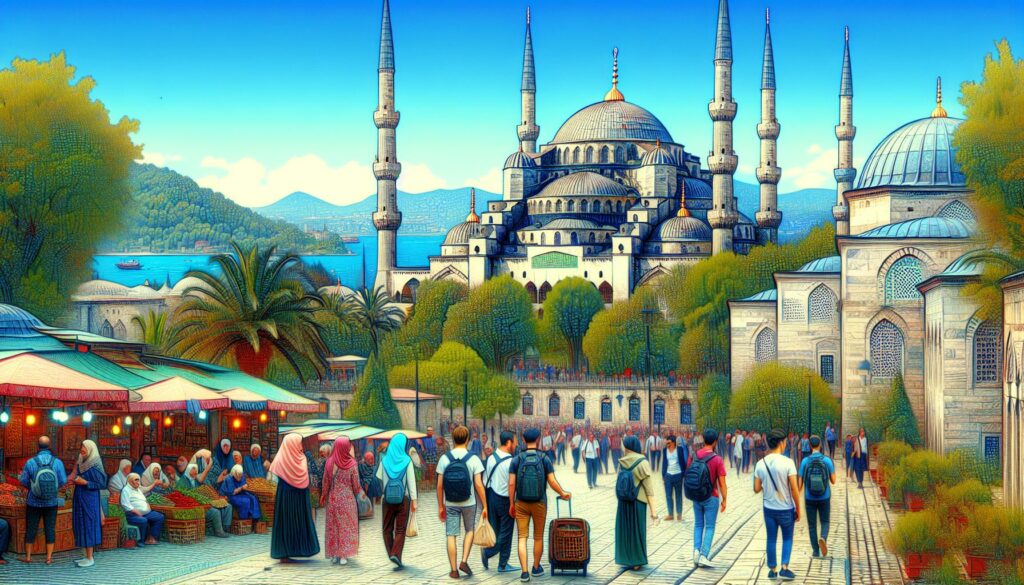Having explored the beautiful:ptv0-t7pkoa= Turkey country enchanting landscapes and rich cultural tapestry I can’t help but marvel at this extraordinary country where East meets West. From the sun-kissed shores of the Mediterranean to the otherworldly landscapes of Cappadocia Turkey never fails to take my breath away.
I’ve discovered that Turkey’s beauty extends far beyond its natural wonders. The country’s architectural masterpieces like the stunning Blue Mosque and ancient ruins of Ephesus stand as testament to its incredible history. The warm hospitality of Turkish people their vibrant bazaars and mouthwatering cuisine create an immersive experience that’s truly unforgettable.
Key Takeaways
- Turkey’s unique geography spans two continents, featuring diverse landscapes from Mediterranean coastlines to Cappadocia’s otherworldly rock formations and deep underground cities
- The country’s rich architectural heritage includes iconic structures like the Blue Mosque (with 20,000 handmade tiles) and the ancient city of Ephesus, reflecting over 10,000 years of civilization
- Turkish hospitality (“”misafirperverlik””) is deeply embedded in the culture, with distinct customs like serving coffee or tea within 5 minutes of a guest’s arrival
- The best time to visit varies by region, with spring (March-May) and fall (September-November) offering ideal temperatures of 15-25°C for most activities
- Comprehensive transportation options include domestic flights connecting 55 airports, high-speed trains linking 8 major cities, and extensive bus networks throughout the country
Beautiful:ptv0-t7pkoa= Turkey Country
beautiful:ptv0-t7pkoa= Turkey country diverse topography spans two continents, featuring dramatic coastlines, ancient volcanic formations, and pristine mountain ranges. I’ve explored these natural wonders that showcase the country’s geological diversity and breathtaking beauty.
Mediterranean Coastlines and Turquoise Waters
The Turkish Riviera stretches 1,600 kilometers along the Mediterranean coast, with crystal-clear waters meeting limestone cliffs. I discovered hidden coves at Ölüdeniz’s Blue Lagoon, where turquoise waters create a natural pool surrounded by pine-forested mountains. The Butterfly Valley near Fethiye harbors 80 butterfly species within its 350-meter-high canyon walls. The Mediterranean coastline includes notable features:
- Pristine beaches at Patara extending 18 kilometers
- Secluded bays at Kekova featuring submerged ancient ruins
- Rocky formations at Kaş with underwater caves
- Thermal springs at Pamukkale’s white travertine terraces
- Conical rock formations rising 40 meters high
- Underground cities extending 85 meters deep
- Rose Valley’s pink-hued rock formations spanning 6.4 kilometers
- Uçhisar Castle standing 60 meters tall
- Ihlara Valley’s 16-kilometer canyon with 4,000 cave dwellings
| Landscape Feature | Dimension | Notable Characteristic |
|---|---|---|
| Mediterranean Coast | 1,600 km | Turquoise waters & limestone cliffs |
| Butterfly Valley | 350 m high | Home to 80 butterfly species |
| Patara Beach | 18 km long | Longest beach in Turkey |
| Cappadocia Caves | 85 m deep | Ancient underground settlements |
| Ihlara Canyon | 16 km long | 4,000 rock-hewn dwellings |
Historic Sites and Ancient Ruins
beautiful:ptv0-t7pkoa= Turkey country historic sites reflect 10,000 years of human civilization encompassing Greek, Roman, Byzantine Ottoman empires. I’ve explored iconic landmarks that showcase the country’s architectural evolution through millennia.
The Grand Bazaar and Blue Mosque
The Grand Bazaar spans 61 covered streets containing 4,000 shops dating to 1461. I discovered intricate Turkish carpets, handcrafted ceramics gold jewelry while wandering through its vibrant corridors. The Blue Mosque, completed in 1616, features 20,000 handmade Iznik tiles 200 stained glass windows creating a stunning blue interior that earned its nickname. Its 6 minarets tower above Istanbul’s skyline marking it as one of Islam’s most significant architectural achievements.
Ancient City of Ephesus
Ephesus preserves remarkably intact Greco-Roman ruins spanning 4 square kilometers. I explored the 25,000-seat Great Theater carved into Mount Pion the two-story Celsus Library façade with its original columns inscriptions. The site contains Turkey’s largest collection of Roman artifacts including the Temple of Hadrian marble streets leading to the ancient harbor. Walking through the Terrace Houses reveals 2nd-century AD residential complexes with preserved frescoes mosaics giving insights into elite Roman life.
| Historic Site | Key Features | Construction Period |
|---|---|---|
| Grand Bazaar | 4,000 shops, 61 streets | 1461 AD |
| Blue Mosque | 20,000 tiles, 6 minarets | 1616 AD |
| Ephesus Theater | 25,000 seats | 3rd century BC |
| Celsus Library | 2-story façade | 117 AD |
Turkish Culture and Traditions
Turkish culture embodies a rich tapestry of customs passed down through generations, blending influences from Central Asian, Middle Eastern, and Mediterranean civilizations. I’ve discovered that modern Turkish society maintains strong connections to its traditional values while embracing contemporary lifestyles.
Local Cuisine and Food Experiences
Turkish cuisine reflects diverse regional influences through its extensive use of fresh ingredients, spices, and traditional cooking methods. Each meal starts with meze platters featuring 8-12 small dishes including hummus, babaganoush, and dolma. The kebab culture spans 40 varieties, from classic Adana kebab to İskender kebab served with yogurt and tomato sauce. Turkish breakfast, called kahvaltı, includes 15-20 items such as olives, cheese varieties, eggs, tomatoes, cucumbers, honey, and Turkish tea. The iconic Turkish coffee, prepared in a cezve using finely ground beans, follows a 500-year-old tradition recognized by UNESCO as intangible cultural heritage.
Traditional Turkish Hospitality
Turkish hospitality centers on the concept of “”misafirperverlik,”” treating guests with utmost respect and generosity. I’ve experienced firsthand how Turkish homes maintain dedicated guest rooms decorated with their finest furnishings, reserved exclusively for visitors. The ritual of offering Turkish coffee or tea occurs within 5 minutes of a guest’s arrival, accompanied by lokum (Turkish delight) or other sweets. In traditional settings, hosts serve food in 3 rounds: appetizers, main courses, and desserts, ensuring guests feel welcomed and satisfied. The custom of removing shoes before entering homes demonstrates respect for cleanliness, with hosts providing special slippers called “”terlik”” for their guests.
Best Time to Visit Turkey
Turkey’s climate varies significantly across regions, offering distinct experiences throughout the year. I’ve found specific months ideal for different activities based on weather patterns and regional characteristics.
Weather and Seasonal Activities
The Turkish climate divides into distinct seasonal patterns:
Spring (March to May)
- Temperatures: 15-25°C (59-77°F)
- Activities:
- Hiking in Cappadocia valleys
- Exploring ancient ruins in Ephesus
- Witnessing Istanbul Tulip Festival in April
- Photography during cherry blossom season
Summer (June to August)
- Temperatures: 25-35°C (77-95°F)
- Activities:
- Swimming at Mediterranean beaches
- Sailing along the Turkish Riviera
- Paragliding in Ölüdeniz
- Visiting coastal towns like Antalya
- Temperatures: 15-25°C (59-77°F)
- Activities:
- Hot air ballooning in Cappadocia
- Wine tasting in Cappadocia vineyards
- Exploring Istanbul’s Grand Bazaar
- Hiking in the Taurus Mountains
- Temperatures: 5-15°C (41-59°F)
- Activities:
- Skiing at Uludağ Mountain Resort
- Visiting Turkish thermal springs
- Exploring museums in Istanbul
- Photography in snow-covered Cappadocia
| Region | Peak Season | Average Temperature | Rainfall |
|---|---|---|---|
| Istanbul | April-May | 20°C (68°F) | 45mm |
| Cappadocia | June-August | 27°C (81°F) | 20mm |
| Mediterranean Coast | July-September | 30°C (86°F) | 10mm |
| Black Sea Region | May-September | 23°C (73°F) | 70mm |
Getting Around Turkey
beautiful:ptv0-t7pkoa= Turkey country comprehensive transportation network makes exploring the country efficient. A combination of domestic flights, high-speed trains, buses, and local transit systems connects major cities and tourist destinations.
Transportation Tips and Options
Domestic flights operate between 55 airports across Turkey, with Turkish Airlines offering 300+ daily routes. Here’s a breakdown of key transportation options:
Air Travel
- Istanbul Airport (IST) serves as the main hub with connections to 15 domestic destinations
- Pegasus Airlines offers budget-friendly alternatives on 45 domestic routes
- Flight times average 1-2 hours between major cities
Train Services
- High-speed YHT trains connect 8 major cities including Istanbul, Ankara and Konya
- Standard trains cover 20 regional routes across the country
- E-tickets available through TCDD’s mobile app
Bus Network
- Extensive intercity bus system with 50+ companies operating nationwide
- Modern buses equipped with WiFi, entertainment systems and refreshment service
- Main terminals located in city centers with frequent departures
Local Transportation
- Metro systems in 8 major cities including Istanbul’s 145km network
- Dolmuş (shared taxis) run fixed routes in urban areas
- Local buses operate with İstanbulkart payment system in major cities
Car Rental
- International agencies present at 30 airports nationwide
- Local companies offer competitive rates starting at $25/day
- International driving permit required for rentals
- Regular boats connect Istanbul’s European and Asian sides
- Coastal ferries link major ports along Mediterranean coast
- Island services available to popular destinations like Princes’ Islands
| Mode | Distance | Cost (USD) |
|---|---|---|
| Domestic Flight | Istanbul-Antalya | 45-90 |
| High-speed Train | Istanbul-Ankara | 25-40 |
| Intercity Bus | Istanbul-Cappadocia | 20-35 |
| Metro Ride | Within city | 0.50-1 |
| Ferry Crossing | Bosphorus | 1-2 |
An Experience that Awakens All Senses
beautiful:ptv0-t7pkoa= Turkey country has left an indelible mark on my heart with its extraordinary blend of natural wonders cultural treasures and warm hospitality. From the ethereal landscapes of Cappadocia to the sun-kissed Mediterranean coastline I’ve discovered a country that exceeds all expectations.
My journey through this magnificent land has shown me that Turkey isn’t just a destination – it’s an experience that awakens all senses. Whether you’re seeking ancient history pristine beaches culinary delights or cultural immersion Turkey delivers it all with grace and authenticity.
I’ve found that Turkey’s true beauty lies not only in its stunning landscapes and historic monuments but in the genuine warmth of its people. It’s a place where traditions thrive modern life flourishes and every visitor is made to feel at home.

